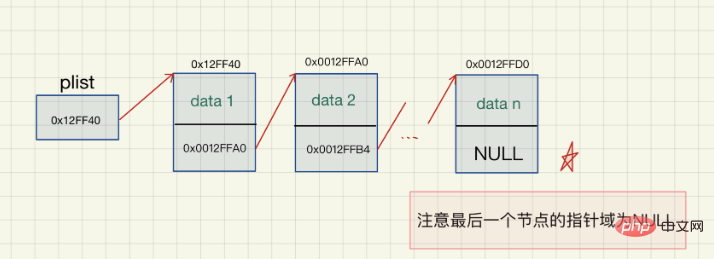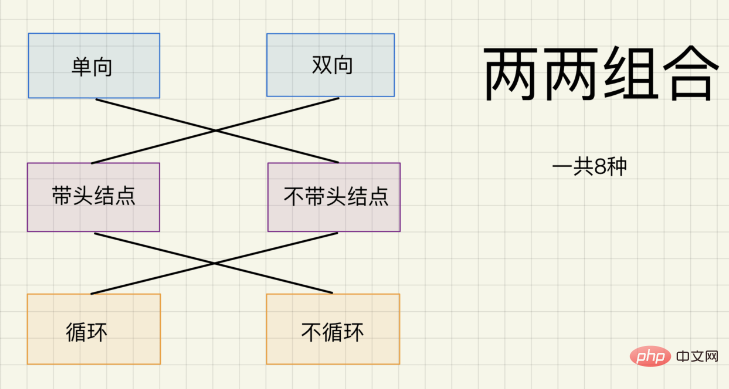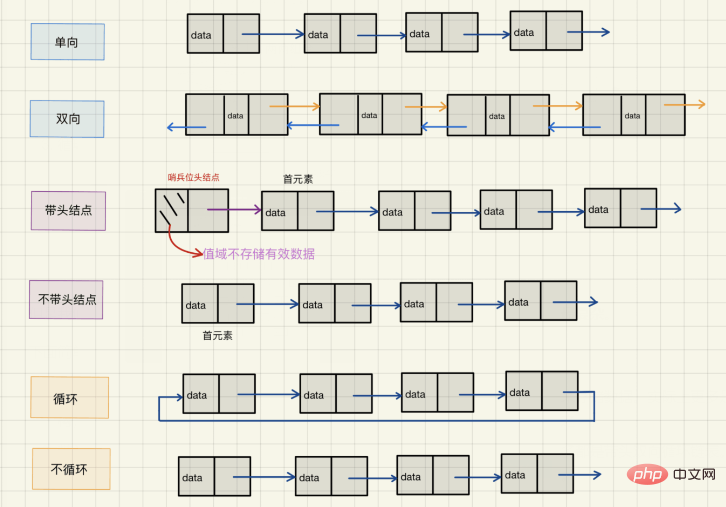What is the concept and structure of linked list in Java data structure?
1. The concept of linked list
Concept:The linked list is a non-continuous and non-sequential storage structure in the physical storage structure. The logical order of the data elements is realized through the pointer link order in the linked list. ’s
1. A linked list consists of a series of nodes (each element in the linked list is called a node).
2. Nodes can be generated dynamically (malloc) at runtime.
3. Each node includes two parts: one is the data field that stores data elements, and the other is the pointer field that stores the address of the next node (see 1.2 Node section for details).
4. Compared with the linear list sequence structure, the linked list operation is complicated. However, since it does not need to be stored in order, the linked list can achieve O(1) complexity when inserting, which is much faster than the sequential list; however, searching for a node or accessing a node with a specific number requires O(n) time, and The sequence list only requires O(1)
2. The node
linked list is composed of nodes, and each node is in the form of a structure. The first variables in the structure are given as needed. The last variable is a pointer of this structure type, which is used to store the first address of the next node‘
The linked list node is divided into two fields
Data field : Store various actual data
Pointer field : Store the address of the next node

(The picture shows a linked list with a sentinel header node)
3. Usage scenarios of linked lists
Linear tables are suitable for using linked storage structures when need to frequently insert or delete data elements.
Because for a linked list, inserting or deleting data only requires creating a node, inputting data, modifying the pointer to connect the node to a certain position in the linked list; and for a sequential list, inserting a Data may need to be moved to other data, which is highly complex.
4. Linked list classification and commonly used structures


Although there are a total of 8 types of linked lists to choose from, In practice, the most commonly used ones are headless one-way non-cyclic linked list and headed two-way cyclic linked list.
1. Headless one-way non-cyclic linked list: commonly known as "singly linked list". The structure is simple and is generally not used to store data alone. In fact, it is more of a substructure of other data structures (such as hash buckets, graph adjacency lists, stack chain structures, etc.)
2. Headed bidirectional circular linked list: the most complex structure, generally used Store data separately. Most of the linked lists actually used are headed bidirectional circular linked lists. Although the structure is the most complex, this structure brings many advantages.
5. Comparison with sequential list
Linked list: Linked list links discrete data into a table through nodes, and inserts and deletes nodes through operations. To achieve access to data.
Sequence table: The sequence table stores data by opening up a continuous memory (directly using an array or malloc and then realloc expansion).
But because realloc expansion is divided into in-situ expansion and off-site expansion, the former is less expensive, while the latter requires not only copying data, but also releasing old space when expanding. Furthermore, when expanding, it will usually be expanded to 2 times the original capacity. Expanding too many times will easily cause a waste of space.
Each member of the sequence table corresponds to a node of the linked list; members and nodes The data type can be a standard C type or a user-defined structure type.
| Comparison object | Sequence list | Linked list |
|---|---|---|
| Storage space | Continuous | Discontinuous |
| Inserting or deleting data | It may be necessary to move data, complexity O (n) | Just need to modify the pointer |
| push | Dynamic sequence table: there is not enough space and needs to be expanded | No "capacity" ” concept, directly malloc the new node when pushing |
| Application | Requires frequent access | Requires frequent insertion and deletion of data |
The above is the detailed content of What is the concept and structure of linked list in Java data structure?. For more information, please follow other related articles on the PHP Chinese website!

Hot AI Tools

Undresser.AI Undress
AI-powered app for creating realistic nude photos

AI Clothes Remover
Online AI tool for removing clothes from photos.

Undress AI Tool
Undress images for free

Clothoff.io
AI clothes remover

Video Face Swap
Swap faces in any video effortlessly with our completely free AI face swap tool!

Hot Article

Hot Tools

Notepad++7.3.1
Easy-to-use and free code editor

SublimeText3 Chinese version
Chinese version, very easy to use

Zend Studio 13.0.1
Powerful PHP integrated development environment

Dreamweaver CS6
Visual web development tools

SublimeText3 Mac version
God-level code editing software (SublimeText3)

Hot Topics
 1663
1663
 14
14
 1419
1419
 52
52
 1313
1313
 25
25
 1263
1263
 29
29
 1236
1236
 24
24
 Break or return from Java 8 stream forEach?
Feb 07, 2025 pm 12:09 PM
Break or return from Java 8 stream forEach?
Feb 07, 2025 pm 12:09 PM
Java 8 introduces the Stream API, providing a powerful and expressive way to process data collections. However, a common question when using Stream is: How to break or return from a forEach operation? Traditional loops allow for early interruption or return, but Stream's forEach method does not directly support this method. This article will explain the reasons and explore alternative methods for implementing premature termination in Stream processing systems. Further reading: Java Stream API improvements Understand Stream forEach The forEach method is a terminal operation that performs one operation on each element in the Stream. Its design intention is
 PHP: A Key Language for Web Development
Apr 13, 2025 am 12:08 AM
PHP: A Key Language for Web Development
Apr 13, 2025 am 12:08 AM
PHP is a scripting language widely used on the server side, especially suitable for web development. 1.PHP can embed HTML, process HTTP requests and responses, and supports a variety of databases. 2.PHP is used to generate dynamic web content, process form data, access databases, etc., with strong community support and open source resources. 3. PHP is an interpreted language, and the execution process includes lexical analysis, grammatical analysis, compilation and execution. 4.PHP can be combined with MySQL for advanced applications such as user registration systems. 5. When debugging PHP, you can use functions such as error_reporting() and var_dump(). 6. Optimize PHP code to use caching mechanisms, optimize database queries and use built-in functions. 7
 PHP vs. Python: Understanding the Differences
Apr 11, 2025 am 12:15 AM
PHP vs. Python: Understanding the Differences
Apr 11, 2025 am 12:15 AM
PHP and Python each have their own advantages, and the choice should be based on project requirements. 1.PHP is suitable for web development, with simple syntax and high execution efficiency. 2. Python is suitable for data science and machine learning, with concise syntax and rich libraries.
 PHP vs. Other Languages: A Comparison
Apr 13, 2025 am 12:19 AM
PHP vs. Other Languages: A Comparison
Apr 13, 2025 am 12:19 AM
PHP is suitable for web development, especially in rapid development and processing dynamic content, but is not good at data science and enterprise-level applications. Compared with Python, PHP has more advantages in web development, but is not as good as Python in the field of data science; compared with Java, PHP performs worse in enterprise-level applications, but is more flexible in web development; compared with JavaScript, PHP is more concise in back-end development, but is not as good as JavaScript in front-end development.
 PHP vs. Python: Core Features and Functionality
Apr 13, 2025 am 12:16 AM
PHP vs. Python: Core Features and Functionality
Apr 13, 2025 am 12:16 AM
PHP and Python each have their own advantages and are suitable for different scenarios. 1.PHP is suitable for web development and provides built-in web servers and rich function libraries. 2. Python is suitable for data science and machine learning, with concise syntax and a powerful standard library. When choosing, it should be decided based on project requirements.
 Java Program to Find the Volume of Capsule
Feb 07, 2025 am 11:37 AM
Java Program to Find the Volume of Capsule
Feb 07, 2025 am 11:37 AM
Capsules are three-dimensional geometric figures, composed of a cylinder and a hemisphere at both ends. The volume of the capsule can be calculated by adding the volume of the cylinder and the volume of the hemisphere at both ends. This tutorial will discuss how to calculate the volume of a given capsule in Java using different methods. Capsule volume formula The formula for capsule volume is as follows: Capsule volume = Cylindrical volume Volume Two hemisphere volume in, r: The radius of the hemisphere. h: The height of the cylinder (excluding the hemisphere). Example 1 enter Radius = 5 units Height = 10 units Output Volume = 1570.8 cubic units explain Calculate volume using formula: Volume = π × r2 × h (4
 PHP's Impact: Web Development and Beyond
Apr 18, 2025 am 12:10 AM
PHP's Impact: Web Development and Beyond
Apr 18, 2025 am 12:10 AM
PHPhassignificantlyimpactedwebdevelopmentandextendsbeyondit.1)ItpowersmajorplatformslikeWordPressandexcelsindatabaseinteractions.2)PHP'sadaptabilityallowsittoscaleforlargeapplicationsusingframeworkslikeLaravel.3)Beyondweb,PHPisusedincommand-linescrip
 PHP: The Foundation of Many Websites
Apr 13, 2025 am 12:07 AM
PHP: The Foundation of Many Websites
Apr 13, 2025 am 12:07 AM
The reasons why PHP is the preferred technology stack for many websites include its ease of use, strong community support, and widespread use. 1) Easy to learn and use, suitable for beginners. 2) Have a huge developer community and rich resources. 3) Widely used in WordPress, Drupal and other platforms. 4) Integrate tightly with web servers to simplify development deployment.




